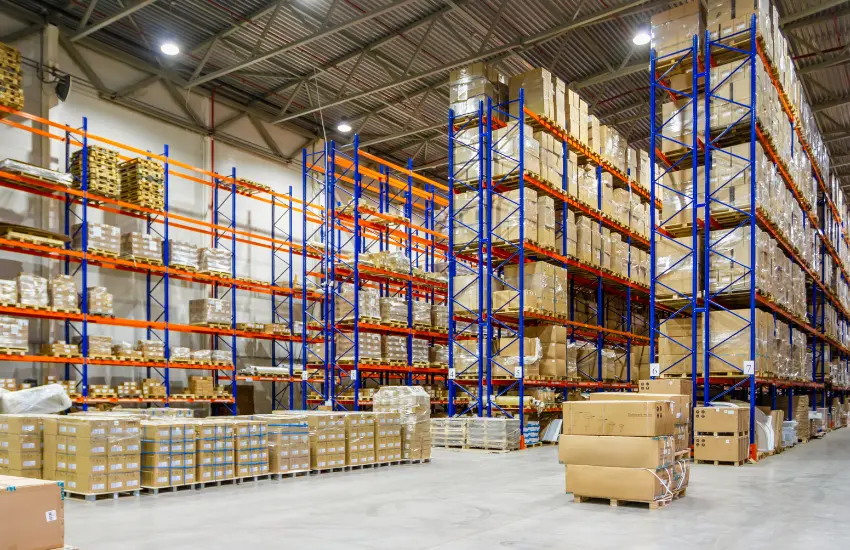Opening or relocating to a new distribution center requires significant planning, especially as the e-commerce industry continues to boom. Forbes recently reported that the global e-commerce market is projected to reach $6.3 trillion in 2023 and over $8.1 trillion by 2026, which means a massive amount of inventory will be moving in and out of warehouses.
However, most companies are not experienced in the level of planning required to establish warehouse capacity. Missing a step or neglecting to consider important components when calculating storage needs can lead to significant problems.
Today, we’ll delve deeper into what warehouse capacity planning entails and provide insights on determining the appropriate amount of space you’ll need. By understanding the key factors, you can avoid pitfalls and ensure the size of your warehouse is accurate and efficient.
What is Warehouse Capacity Planning?
Warehouse capacity planning involves managing the inventory stock stored in your warehouse. With inventory constantly moving in and out, it’s essential to ensure that you have enough of the right stock to meet customer demand while maintaining sufficient space to receive and distribute your goods efficiently. At the same time, it’s crucial to avoid having unsold inventory taking up valuable space.
To achieve these goals, you’ll need to know how to calculate your warehouse space utilization. By understanding the principles of warehouse capacity planning and space utilization, you can optimize your warehouse operations and improve your overall efficiency.

Warehouse Capacity Planning: Considerations for Calculating Storage
Evaluating Inventory Turnover
To accurately determine your warehouse capacity needs, it’s essential to understand your regular inventory requirements and turnover rates.
For instance, if certain inventory is expensive to acquire quickly, you may need to reserve extra storage space, compared to inventory that is small or moves quickly, thus requiring less space. Here are some questions to consider when calculating storage requirements for your new warehouse space:
- Which stock items move quickly and need to be consistently replenished?
- How long does it take for fast-moving inventory to arrive?
- How long does it take for less popular items to arrive without paying expedited freight costs?
- How much dead inventory do you currently store?
- How much space does your non-moving inventory take up?
- Is there a way to reduce the amount of dead inventory in your warehouse space?
Estimating Sales Growth
Your company’s growth is another crucial factor to consider. Is your current space scalable enough to support any sales growth you might experience? When considering this, you’ll need to think about the size and shape of the products you’re selling. Are they larger, heavier, wider, or longer? If not, will you be adding these types of items to sell? If so, you’ll need to calculate more space.
While you don’t want to purchase or outsource a larger warehouse space than you’ll ever utilize, if you experience a significant surge in sales, you’ll want to be able to support the storage space you will need to have in your warehouse.
When calculating warehouse capacity, factor in your sales plan for approximately the next three years as best as you can forecast. You might consider employing warehousing and distribution services to help you with storage needs and ensure all your fulfillment obligations are met on time.
Warehouse Shape and Square Footage
To maximize efficiency in your new warehouse, think about the shape of the space and how much square footage you actually need. Some warehouses have odd shapes that are difficult to work with, while others offer very efficient layouts. Before investing in warehouse space, be sure to consider the warehouse’s current actual layout, cubic feet, vertical storage, and the number of dock doors.
Additionally, consider whether you have designated areas in your warehouse for quality assurance, staging, storage, returns, refurbishment, or any other services you offer your customers. By understanding your space requirements and aligning them with the available square footage in your warehouse, you can improve your ability to accurately plan for your current and future warehouse capacity needs. Doing so will enhance your operational efficiency and allow you to serve your customers better.
Inventory Visibility
Having adequate warehouse space is essential, but it’s not enough to achieve optimal efficiency and profitability. To accomplish these goals, you must clearly understand your inventory and its physical location. This is where inventory visibility comes into play.
Inventory visibility refers to the ability to track inventory in real time and know precisely where it is located within the warehouse. This is critical because you cannot recoup the money you spend on inventory until it sells. Therefore, you need to quickly and accurately locate your inventory to fulfill orders and avoid stockouts, which can lead to lost sales and decreased customer satisfaction.
Call Meyer Inc for Your Warehouse Planning Needs
Planning for warehouse capacity can be a complex process. If you’re new to this and finding it challenging, consider seeking help from storage solution experts. At Meyer Inc, we offer customized warehouse, distribution, and order fulfillment services, and we have experts who can help you calculate your storage needs.
We use the latest technology and efficient processes to help you through any type of transition or change your business needs to make. We provide a wide range of services, including warehousing and distribution services, inventory management, pick, pack, and ship services, kitting, packaging, and assembly.
Before committing to a long-term lease or investing in expensive real estate, contact us to discuss your warehousing needs. We’ll guide you every step of the way to ensure you have the optimal space to manage your inventory, logistical, and storage needs. With our expertise, you can rest assured that your warehouse capacity planning will be accurate and efficient.